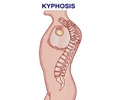Osteoporosis, or bone loss, is a disease that is most common in the elderly population, affecting women more often than men.
Osteoporosis, or bone loss, is a disease that is most common in the elderly population, affecting women more often than men. Until now, it was not clear exactly how the disease develops. Researchers of the Max Delbrück Center for Molecular Medicine (MDC) Berlin-Buch, Germany, have now elucidated a molecular mechanism which regulates the equilibrium between bone formation and bone resorption. Dr. Jeske J. Smink, Dr. Valerie Begay, and Professor Achim Leutz were able to show that two different forms of a gene switch – a short isoform and a long isoform – determine this process. The MDC researchers hope these findings will lead to new therapies for this bone disease. (EMBO Journal)*.
In osteoporosis, excessive bone resorption occurs. The bones lose their density and are therefore prone to breakage. Even minor falls can lead to serious bone fractures. The interplay between two cell types determines bone density: bone forming cells (osteoblasts) and bone resorbing cells (osteoclasts). The equilibrium between these two cell types is strictly regulated to prevent the formation of either too much or too little bone.LAP and LIP maintain the balance
Dr. Smink, Dr. Bégay, and Professor Leutz have now elucidated a complicated mechanism which maintains the equilibrium between bone formation and bone resorption. Here, the gene switch C/EBPbeta plays a major role. It exists in different forms, differing in length and number of building blocks. LAP is the term researchers use to denote the full-length isoform of C/EBPbeta, and LIP is the term for the short isoform.
LAP activates another gene switch (MafB) which suppresses the formation of bone resorbing osteoclasts. In contrast, LIP, suppresses this gene switch and thus enhances the proliferation and activity of the osteoclasts. As a result, the osteoclasts resorb more bone substance than is built by the osteoblasts. The researchers suspect that imbalance in the ratio between LAP and LIP plays a role in osteoporosis.
The activity of a signaling molecule – mTOR – determines which of the two isoforms LAP and LIP is formed. The abbreviation mTOR stands for mammalian Target of Rapamycin. The drug rapamycin inhibits mTOR and thus suppresses the formation of bone resorbing osteoclasts.
Unfortunately, rapamycin has severe side-effects on the immune system. "In the future, it may be possible to develop new drugs that regulate the activity of mTOR and, thus, remedy the disturbance in osteoclast function," Professor Leutz said.
LIN











